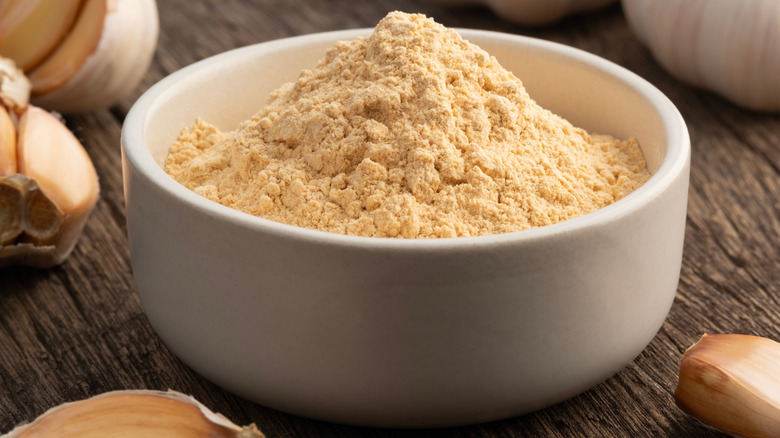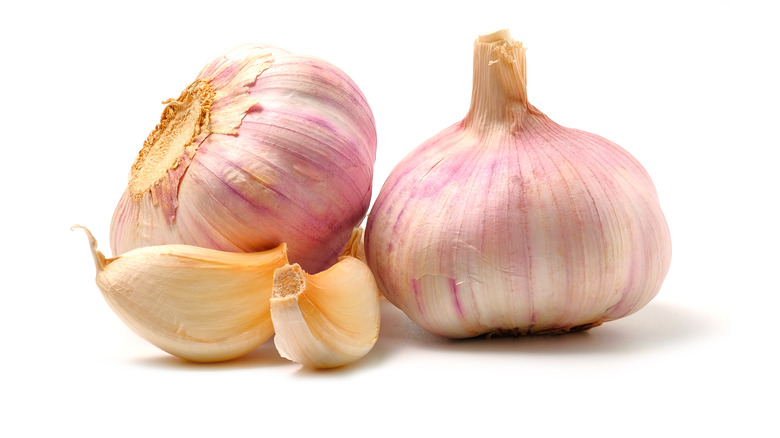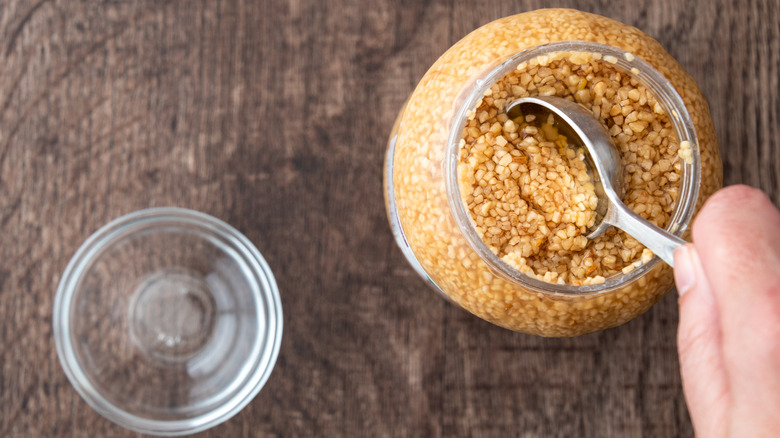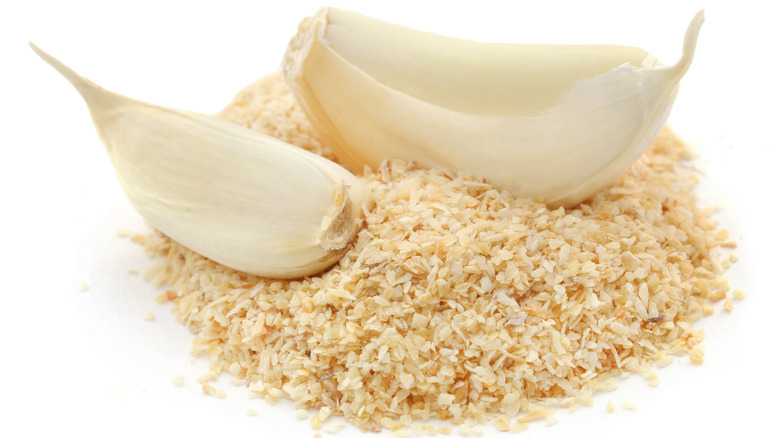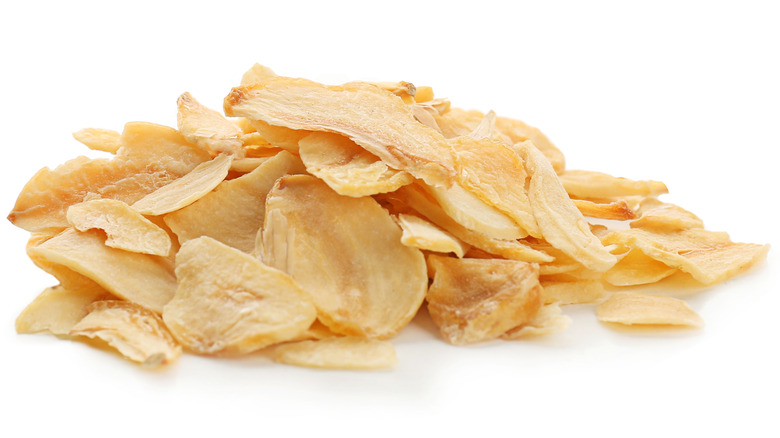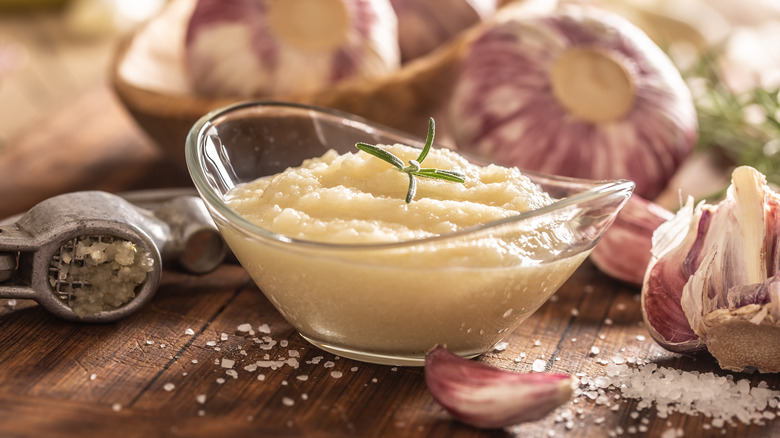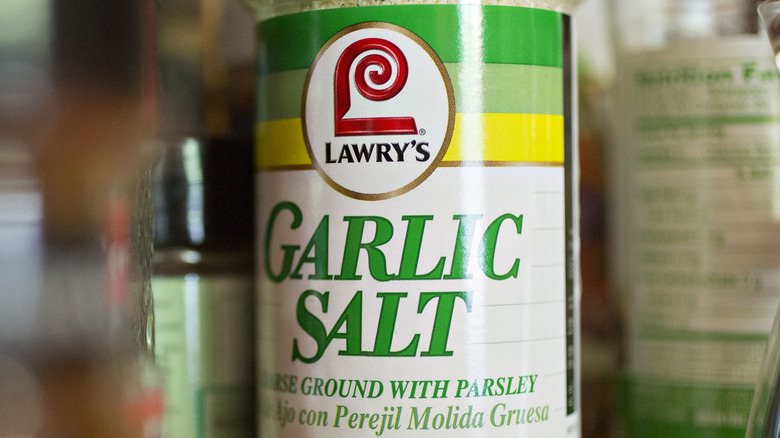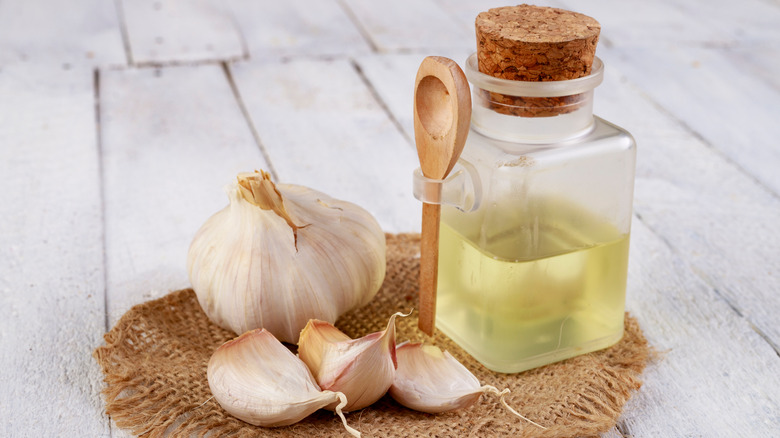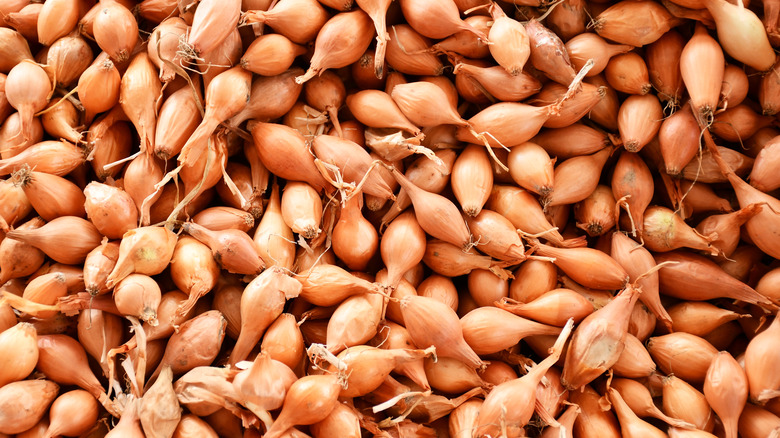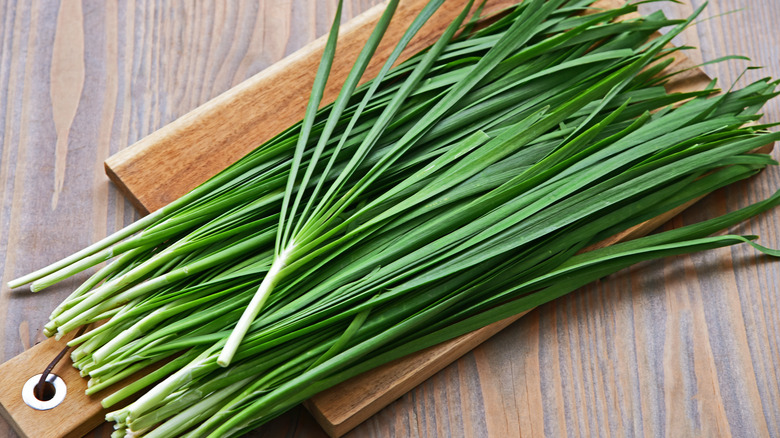10 Best Substitutes For Garlic Powder
If you could only have access to one spice for the rest of your life, what is it and why would it be garlic powder? Next to salt and pepper, we're willing to bet that you reach for this particular ingredient more often than almost anything else in your spice cabinet, and it's pretty easy to see why. The spice, which is simply dehydrated garlic that has been ground up into a fine powder (via Gourmet Sleuth), is available at just about any grocery store, and for a low price at that. It packs an intense, concentrated garlicky flavor that works wonders on a number of dishes including soups, stews, and sauces. It can also be incorporated into a dry rub for meat, a seasoning for popcorn, and, of course, is the start player when making up a batch of delectable garlic bread to enjoy with a heaping plate of spaghetti.
When it comes to cooking, you might think there's no such thing as too much garlic powder, and we can't say that we don't agree. However, this mantra could eventually leave you with an empty container after a few too many nights of going heavy-handed with the spice. Does this mean that your dinner is ruined unless you can put everything on pause for a trip to the store? Absolutely not! There are plenty of potential substitutions for the ingredient, and if you're a garlic fiend like us, you probably already have a few of them on hand.
1. Fresh garlic
Fresh garlic may seem like an obvious solution to the dilemma of running out of garlic powder while in the middle of cooking, but the swap isn't as easy as it seems. This substitution is best in recipes for soups, spreads, and pasta, or anything that involves some sort of sauteing (via Food Shark Marfa). However, if you're trying to put together a spice mix for meat, you're better off finding something else since fresh garlic will be difficult to blend. This substitution also requires a bit more effort since garlic cloves will need to be peeled and sliced before use, which might be difficult if you're like Ina Garten and don't keep a garlic press on hand. Food Shark Marfa points out that it will be well worth the work as your final dish will be heavier in flavor, not to mention that your kitchen will be filled with the mouthwatering scent of the allium.
Garlic in powdered form is much more concentrated than its fresh counterpart, so you will need more for this replacement. Substitute Cooking suggests using one full clove for every ⅛ teaspoon of garlic powder called for in the recipe for best results.
2. Minced garlic
You might not be one to purchase full bulbs of garlic at the store, and we don't blame you – having to peel and slice those little cloves can be a somewhat annoying task, especially when regularly cooking with garlic. Fortunately, there are jars of pre-minced garlic available that will leave you with clean hands and little mess to clean up since there is no chopping involved, and can also save you when the canister of garlic powder runs out. This substitution is similar to fresh garlic in that it is better used in recipes that involve sauteeing or slow cooking time rather than being employed as a rub, though Fitibility points out that it will also add a hint of acidity to your dish as well, which could affect the final results.
Interestingly enough, minced garlic is actually more intense in flavor than garlic powder, making this swap one of the few times you'll want to cut back on the ingredient. According to Spiceography, you'll want to use half the amount of minced garlic as you would garlic powder, though you can easily add in a little bit more if you'd like.
3. Granulated garlic
If we were to have to dub one item on this list as the best substitution for garlic powder, granulated garlic would have to be it. This may be surprising, considering fresh garlic is, well, fresh, but this form of the allium works in a wider variety of recipes. Like garlic powder, the granulated ingredient comes from dehydrated cloves, though it has a much coarser texture that is similar to cornmeal. It may take some extra time to incorporate this ingredient into your food since it won't dissolve as easily (via Food Shark Marfa), and you may be able to detect the textural difference in your final dish. However, in terms of flavor, Fitibility says that the results should be nearly identical.
As Food Shark Marfa points out, the fine consistency of garlic powder also means it is more potent than granulated garlic. To make up for this, Spiceography says that you'll need to double the amount of granulated garlic when using it as a replacement for garlic powder in your cooking.
4. Garlic flakes
Garlic flakes are another suitable substitution for garlic powder that you might already have sitting in your spice cabinet, though they may be cleverly disguised as "minced garlic" on the label. That is because this ingredient is made up of pieces of minced garlic that have been dehydrated. Per Miss Vickie, this swap should be reserved only for liquid recipes, which will allow the flakes to rehydrate and inject the proper garlic flavor into the dish.
We mentioned earlier that jarred minced garlic is more potent than garlic powder, but that is not the case when it comes to the ingredient in its dehydrated form. According to Miss Vickie, subbing in garlic flakes could require you to use four times the amount of garlic powder called for in your recipe to ensure that you get the proper flavor and aroma from the ingredient. A Couple Cooks notes that you could also further grind the flakes down into a powdery substance, which can be used in a 1:1 ratio.
5. Garlic puree
Garlic puree is exactly what it sounds like: fresh garlic cloves that have been pureed in a blender into a paste-like substance. It is easy to make at home or can be found at the store, often in a long tube, and if you happen to have either version on hand, you can absolutely use it when you are out of garlic powder. As Food Shark Marfa notes, this ingredient does an excellent job at blending into foods, making it a great replacement in things like pasta, spreads, and sauces. However, it does contain a considerable amount of oil, making it higher in calorie count than a few of the other options on this list.
Subbing in garlic puree is another one of the rare instances that you'll need to cut back on the amount that you use in your recipe since it is more potent than the powdered ingredient. Miss Vickie suggests replacing every tablespoon of garlic powder called for with only ¼ tablespoon of garlic puree.
6. Garlic salt
If you couldn't tell by the name, garlic salt is an amalgamation of salt and garlic powder that is conveniently packed into one jar. It can easily be used in times that you don't have any standalone garlic powder on hand, especially in recipes that call for salt as an ingredient as well. However, since garlic salt is typically made up of one part garlic powder and three parts salt (via Miss Vickie), you'll want to exercise some caution when making this swap.
For best results, Spiceography says that you'll want to use twice the amount of garlic salt in place of garlic powder, but, again, keep in mind that this will bring a considerable amount of salt into your dish as well. Take note of other salty ingredients in your recipe before getting started, and consider cutting back on them or omitting them completely so your food doesn't end up overly salted – a mistake that could potentially render it inedible.
7. Garlic juice
Garlic juice may sound like an odd concept at first, and while we agree that just because something can be juiced doesn't mean it should be juiced, there is a surprisingly long list of health benefits that can come from ingesting this product. Per Organic Facts, this ingredient is the product of garlic puree (remember when we talked about that?) that has been strained, which leaves you with a potent liquid that, among other things, can boost your immune system and reduce hair loss. As it turns out, garlic juice can also be used in place of garlic powder, so if you're into this health craze, you've got another suitable substitution on hand that Fitability says works particularly well in marinades and pasta.
In terms of flavor, Food Shark Marfa explains that garlic juice is about twice as strong as the allium in powdered form. Therefore, you will want to use half the amount of this ingredient when swapping it in a recipe that calls for garlic powder.
8. Shallots
Now that we've explained how to replace garlic powder with the other popular garlic-based ingredients on the market, we can get into some non-garlic options, starting with shallots. This ingredient is a member of the allium family, making it a relative of garlic that is said to have a detectable garlic flavor behind their milder onion taste. Hence, shallots can be used as a substitution for garlic powder in dip recipes as well as ramen and pasta – just make sure to get them going early in the cooking process to ensure that you get the full extent of their flavor (via Fitability).
When using shallots in place of garlic powder, make sure to dice them up small enough so they don't affect the texture of your dish too much. Once you've got them finely chopped, Fitability says you can use 1 ½ teaspoon of shallots as a substitution for one teaspoon of garlic powder.
9. Chives
Chives are another pungent member of the allium family that Fitability describes as having a "delicate" flavor. They can often be found in large bundles that resemble long stalks of grass, or in dried form as well. Both can be used as a replacement for garlic powder, but not in the same way. For instance, fresh chives that are finely diced can help evoke a garlicky flavor in dips, dressings, and ramen, though A Couple of Cooks says they may not work as well in a spice blend, which is where dried chives can be of service.
Fitability advises to only use the green part of fresh chives when using them in place of garlic powder, which, like shallots, should be chopped up small enough to avoid altering the final texture of your dish too much. From there, you can substitute two teaspoons of the herb for every teaspoon of garlic powder that your recipe calls for.
10. Asafoetida powder
Asafoetida powder is our final suggestion for something to flavor your food with if you don't have any garlic powder on hand, or need to avoid garlic products for health reasons. You may not be familiar with this ingredient, but it has been used for many years, especially in Indian cuisine, and is said to be gentler on the digestive system. Per The Spice People, asafoetida powder – also referred to as hing – has an exceptionally pungent smell that may be offputting at first but, once cooked, it will mellow out into something that can act as a replacement for both garlic and onion. It is often used in vegetarian dishes, but can also work in salad dressings, cheese dishes, eggs, and fish (via Substitute Cooking).
As The Spice People points out, a little bit of asafoetida powder can do a lot to a dish. When using it in place of garlic powder, it is best to start out with only a pinch and gradually add more in small amounts until you get the ideal flavor.
